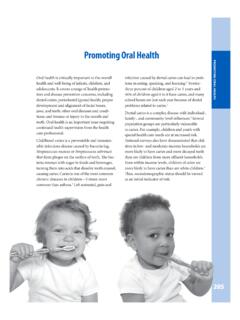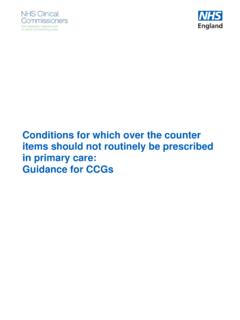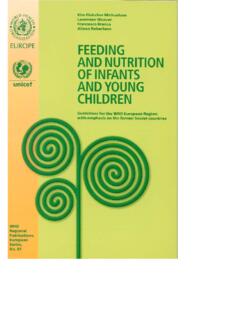Transcription of Periodontal Treatment Protocol (PTP) for the General ...
1 16 The Journal of dental HygieneSpecial supplementIntroductionHujoel et al1estimated a 31%decrease in the prevalence of periodon-titis between the years 1955 and , these authors estimate an addi-tional 8% decrease by the year 2020. Inspite of the decreased use of smokingtobacco,2better understanding of thepathogenesis of Periodontal diseases,and more refined and goal directed ther-apies, there remains evidence that den-tistry is not consistently achieving atimely diagnosis and appropriate andtimely Treatment of existing ,4 Although the evidence is limited,there is a strong suggestion that use of aperiodontal probe for diagnosis andrecording of Periodontal status in treat-ment records in General dental practiceshas yet to achieve the level of a routineand consistent , McFallet al8determined that except for radi-ographs.
2 Most private practice patientrecords were so deficient in diagnosticinformation that Periodontal status couldnot be established. It should be self-evi-dent that Treatment requires a definitivediagnosis, ie, a disease cannot be ade-quately treated unless first this regard, it is interesting to notethat at least one study has reported a dis-connect between dentists perception oftreatment rendered and actual treatmentas recorded in patient anexample, prophylactic procedures out-number Periodontal procedures by aratio of 20:111,12and yet the prevalence ofchronic periodontitis (slight, moderate,and severe) is estimated to range from alow of 7% (aged >18 years)13up to 35%(aged >30-90 years)14of the US et the pattern ofreferral of periodontitis patients in 1980vs 2000 using patient record data from3 geographically-diverse private peri-odontal practices.
3 Results showed thefollowing trends occurring over the 20-year time span: decreased use oftobacco; increase in the percentage ofcases exhibiting advanced chronic peri-odontitis with a concomitant decreasein the percentage of mild-moderate dis-ease cases; increase in the average num-ber of missing teeth per patient; andincrease in the average number of teethscheduled for extraction per patient. Asimilar study by Docktor et al4based onpatient records from 3 private peri-odontal practices located within a majormetropolitan area reported the follow-ing: 74% of referred cases were con-sidered advanced periodontitis, ofwhich 30% were Treatment planned forextraction of 2 or more teeth; periodon-tal Treatment provided by the generaldental office did not vary because ofdisease severity.
4 And the average num-ber of Periodontal maintenance vis-its/patient/year in the General dentaloffice was less than the standard of careaccording to severity of disease, eg,68% of advanced periodontitis casesreported between 0 and 2 periodontalmaintenance visits per year rather thanthe recommended every 3 in aggregate, the trendsreported by Cobb et al3and Docktor etal4support the assertion that timelydiagnosis and appropriate and timelytreatment of chronic periodontitis haveAbstractA sequence of interrelated steps is inherent to effective periodontaltreatment: early and accurate diagnosis, comprehensive Treatment , andcontinued Periodontal maintenance and monitoring.
5 A primary goal ofperiodontal therapy is to reduce the burden of pathogenic bacteria andthereby reduce the potential for progressive inflammation and recur-rence of disease. Emerging evidence of possible perio-systemic linksfurther reinforces the need for good Periodontal health. In the privatepractice setting, the Treatment of patients with Periodontal disease is bestaccomplished within the structure of a uniform and consistent Peri-odontal Treatment Protocol (PTP). Such a Protocol would reinforceaccurate and timely diagnosis, Treatment needs based on a specificdiagnosis, and continual assessment and monitoring of outcomes. Thisis best achieved if everyone in the practice setting has a General under-standing of the etiology of Periodontal diseases, the benefits of treat-ment, and potential consequences of nontreatment.
6 Communicationskills and patient education are vital components of effective therapysince slight and even moderate stages of the disease often have fewnoticeable symptoms to the patient. Accurate documentation and report-ing of procedures for dental insurance reimbursement, coupled withscheduling considerations, assist General practice settings in effectivelymanaging the increasing volume of patients that can benefit from earlydiagnosis and Treatment of Periodontal diseases. This article presentsthe essential elements of a PTP including diagnosis, Treatment planning,implementation of therapy, assessment and monitoring of therapy, insur-ance coding, introduction of the patient to Periodontal therapy, andenhanced verbal skills.
7 In addition, considerations for implementation ofadjunctive local delivery antimicrobials is presented. Key Words: Periodontal diseases, Periodontal diagnosis, treatmentprotocol, Periodontal maintenance, Periodontal assessment, patienteducationPeriodontal Treatment Protocol (PTP) for the General dental PracticeLarry A. Sweeting, DDS; Karen Davis, RDH, BSDH; Charles M. Cobb, DDS, PhDSpecial supplementThe Journal of dental Hygiene17not significantly improved over time. Amajor reason for the reported scarcity oftimely diagnosis and appropriate treat-ment may be the lack of a well-estab-lished office Protocol for the diagnosis, Treatment , maintenance, and monitor-ing of Periodontal disease, and involve-ment of the patient through , this requires dedication ofenergy, resources, effective communi-cation skills, and a change in practicephilosophy.
8 The PeriodontalTreatment Protocol (PTP) DiagnosisRegardless of recent advances in ourunderstanding of the etiology and patho-genesis of the Periodontal diseases, theassessment of traditional clinical param-eters remain the foundation for peri-odontal , such clin-ical parameters include probing depth(PD), bleeding on probing (BOP), clin-ical attachment level (CAL), degree offurcation involvement, extent of gingi-val recession, tooth mobility, and plaquescore. Clinicians typically utilize theresults from the Periodontal exam, radi-ographs, and the patient s medical anddental histories to establish a diagnosisand evolve a goal/diagnosis-directedtreatment plan. It has been clearlydemonstrated that different interpreta-tions of the same diagnostic informationcan have a dramatic impact on this reason, a standard-ized approach to Periodontal assess-ments and a working Protocol as to treat-ment parameters would fill a logicalneed in the average General practice set-ting.
9 However, due to extensive over-laps in most classification systems, anystandardized approach is subject to vari-ations in both clinical assessments (eg,variations in probing depth among cli-nicians) as well as the effective Treatment protocolsbegin with a thorough and timely diag-nosis. Six-point probing to measure PDand BOP is the standard of care. Basedon the needs of the patient, current radi-ographs should be evaluated to deter-mine the location and percentage of boneloss. The presence, location, and extentof furcation invasions should be noted, aswell as the location of the gingival mar-gin or CAL. Also, the patient s age is animportant factor, especially in cases ofrapidly progressing disease and deter-mining overall long-term modified version of the AmericanAcademy of Periodontology (AAP)proposed guidelines for a comprehen-sive Periodontal examination is pre-sented in Table , withrespect to a functional PTP for the gen-eral dental practice, only the followingprincipal diagnostic criteria can beaddressed: age, PD, CAL, BOP, toothmobility, furcation involvement, andpercentage of radiographic bone loss.
10 Itmust be emphasized that these criteriarepresent the minimal parameters fordetermining a Periodontal are many other important risk andmodifying factors that will impactdevelopment and progression of diseaseand all such factors must be taken intoconsideration when establishing a defin-Assessment of medical history Assessment of dental historyAssessment of Periodontal risk factors1. Age2. Gender3. Medications4. Presence of plaque and calculus (quantity and distribution)5. Smoking6. Race/Ethnicity7. Systemic disease (eg, diabetes)8. Oral hygiene9. Socioeconomic status and level of educationAssessment of extraoral and intraoral structures and tissuesAssessment of teeth1. Mobility2.






